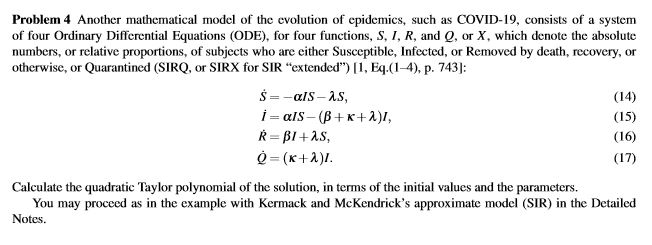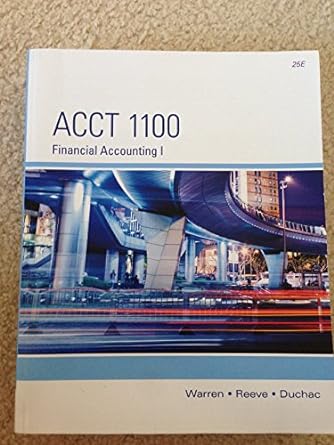

Example 385 One of the many mathematical models of the evolution of epi- demics, which is similar to models of chemical reactions, consists of a system of three Ordinary Differential Equations (ODE), for three functions, S. 1, and R, which denote the absolute numbers, or relative proportions, of subjects who are either Susceptible, Infected, or Removed by death, recovery, or otherwise (SIR). Kermack and McKendrick's approximation with constant rates uses the func- tions x, y, and z, with parameters x and for 2 [27, Eq. (29), p. 713). The recent literature uses the functions S, I, and R, with parameters B and v. The same model is also used for comparisons with other models where the coefficients depend on time as well as on S. 1, and R. deterministically or stochastically, as a result of changes in policies [10]: = -Kxy = = f(K,2;x,y,z), $= -BSI, (8.94) y = Kry-hy=f2(K;2,x,y,z), 1= BS1- vl, (8.95) =hy - 13(x,2;x,y,z), R=vl. (8.96) The left-hand side is the derivative y of a vector-valued function y. The right-hand is a vector-valued function f whose components are analytic functions of y and of the parameters. Therefore, for each initial vector y, at time to = 0, there is exactly one solution, y, and it is an analytic function of and of the parameters. Instead of calculations that follow the proof of analyticity, which has already been proved, an alternative calculation may differentiate the system repeatedly: *=-K-(y+xy) = -K [-kry.y+x-(Kry-2y)], j = K-(xy+xy) 2y=k. [-kxy-y+x- (Kxy 2y)] -2. (Kxy - hy), = ly= 1. (xy-2y). Substituting the initial conditions yo = (x0, Yo,zo) gives the first few terms of the Taylor series of the solution, y(t) = yo +1.yo+%+... x(t)=x0+1-(-xoyo) + (-k). (- KxOyo - Yo + xo - (KX0Yo yo)] yt)=yo+t. (KXoVo - Nyo) + {K- (- KXQyo yo +x. (KXoyo yo)] 1 (KXQXO - yo)}+.. x(t)=30+ 4yo +1(Kxoyo - 1 yo) The derivatives of the solution y with respect to the parameters, K and 1, may be used to assess the reliability of values of K and fitted to data. The method just described applies to any system of ordinary differential equa- tions with differentiable functions to yield Taylor series or Taylor polynomials. +... + ... Example 385 One of the many mathematical models of the evolution of epi- demics, which is similar to models of chemical reactions, consists of a system of three Ordinary Differential Equations (ODE), for three functions, S. 1, and R, which denote the absolute numbers, or relative proportions, of subjects who are either Susceptible, Infected, or Removed by death, recovery, or otherwise (SIR). Kermack and McKendrick's approximation with constant rates uses the func- tions x, y, and z, with parameters x and for 2 [27, Eq. (29), p. 713). The recent literature uses the functions S, I, and R, with parameters B and v. The same model is also used for comparisons with other models where the coefficients depend on time as well as on S. 1, and R. deterministically or stochastically, as a result of changes in policies [10]: = -Kxy = = f(K,2;x,y,z), $= -BSI, (8.94) y = Kry-hy=f2(K;2,x,y,z), 1= BS1- vl, (8.95) =hy - 13(x,2;x,y,z), R=vl. (8.96) The left-hand side is the derivative y of a vector-valued function y. The right-hand is a vector-valued function f whose components are analytic functions of y and of the parameters. Therefore, for each initial vector y, at time to = 0, there is exactly one solution, y, and it is an analytic function of and of the parameters. Instead of calculations that follow the proof of analyticity, which has already been proved, an alternative calculation may differentiate the system repeatedly: *=-K-(y+xy) = -K [-kry.y+x-(Kry-2y)], j = K-(xy+xy) 2y=k. [-kxy-y+x- (Kxy 2y)] -2. (Kxy - hy), = ly= 1. (xy-2y). Substituting the initial conditions yo = (x0, Yo,zo) gives the first few terms of the Taylor series of the solution, y(t) = yo +1.yo+%+... x(t)=x0+1-(-xoyo) + (-k). (- KxOyo - Yo + xo - (KX0Yo yo)] yt)=yo+t. (KXoVo - Nyo) + {K- (- KXQyo yo +x. (KXoyo yo)] 1 (KXQXO - yo)}+.. x(t)=30+ 4yo +1(Kxoyo - 1 yo) The derivatives of the solution y with respect to the parameters, K and 1, may be used to assess the reliability of values of K and fitted to data. The method just described applies to any system of ordinary differential equa- tions with differentiable functions to yield Taylor series or Taylor polynomials. +... +








